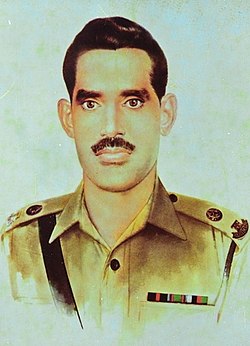Muhammad Akram
Thank you for being part of the Bharatpedia family! 0% transparency: ₹0 raised out of ₹100,000 (0 supporter) |
This article possibly contains original research. (November 2022) |
Muhammad Akram | |
|---|---|
 | |
| Born | 4 April 1938 Dinga, Gujrat Punjab, British India (Present-day Punjab, Pakistan) |
| Died | 5 December 1971 (aged 33) Hilli, Dinajpur, East-Pakistan |
| Buried | |
| Allegiance | |
| Branch/service | |
| Years of service | 1956–71 |
| Rank | |
| Unit | 4 Frontier Force Regiment |
| Battles/wars | Indo-Pakistani war of 1965 Indo-Pakistani war of 1971 |
| Awards | |
| Website | ISPR website |
Major Muhammad Akram NH (Urdu: محمد اکرم; 4 April 1938 – 5 December 1971) was a military officer in the Pakistan Army who was cited with the Nishan-e-Haider posthumously after the military confrontation took place in railway station in Hilli, East-Pakistan.[1]
Biography[edit]
Muhammad Akram belongs to Dinga, a small city in Gujrat District.[2] He was born on 4 April 1938.[3] He was a military brat and his father, Malik S. Muhammad, was an enlisted personnel in the British Indian Army who later retired as a Havildar, an army n.c.o., in the Pakistan Army.[3]
After securing his graduation from a local middle school in Nakka Kalan, Akram entered to join the Military College Jhelum– an ROTC and an army's OCS in Jhelum, Punjab.[3][4]
Lua error in Module:Gallery at line 124: attempt to call field '_warning' (a nil value).In 1953, he dropped out from the Military College Jhelum due to his father's deployment, and had to take the High School equivalency exam where he took examinations in geography and intermediate education.[3]
In 1956, he was enlisted in the Pakistan Army and posted with the 8th Punjab Regiment near India-Pakistan border.[3]
In 1959, Muhammad Akram was selected to attend the Pakistan Military Academy but only spent a semester after being deployed in East-Pakistan as a Naik (equivalent to Corporal).[3]
He received commission in the Army through his years of attendance at the army's OCS in Jhelum in 1961 in the Frontier Force Regiment, and was attached to the East Pakistan Rifles from 1963 to 1965.[3]
In 1965, Capt. Akram was stationed in different parts of the West-Pakistan before being deployed in East-Pakistan as a quartermaster with the Frontier Force Regiment till 1967–68.[3]
Nishan-e-Haider action[edit]
In 1968–70, Maj. Akram served with the 4th battalion posted with the Frontier Force Regiment, eventually Lua error in Module:Gallery at line 124: attempt to call field '_warning' (a nil value).becoming its second-in-command by 1971.[5]
During the east Pakistan War of 1971, the 4th FF Regiment, which at that time was commanded by then Lt. Col. Muhammad Mumtaz Malik, was placed in the forward area of the Hilli Municipality (under Hakimpur Upazila, Dinajpur District), in what was then East Pakistan.[citation needed] The regiment came under continuous and heavy air, artillery and armour attacks from the Indian Army. Despite enemy superiority in both numbers and firepower, Akram and his men repulsed many attacks, inflicting heavy casualties on the enemy.[6] He was killed in action in the attack and was posthumously awarded the Nishan-e-Haider, Pakistan's highest military honour.[6]
He was buried in the village of Boaldar, Thana/Upozila-Hakimpur (Banglahilly), District-Dinajpur. There is a monument, Major Akram Shaheed Memorial, in the midst of Jhelum city.[citation needed]
Awards and Decorations[edit]
| Nishan-e-Haider Recipient | |
|---|---|
| File:Nishan-e-Haider Medal.png Muhammad Akram received the Nishan-e-Haider Award | |
| Date | 1971 |
| Country | Islamic Republic of Pakistan |
| Presented by | President Zulfiqar Ali Bhutto |
| Nishan-e-Haider
(Emblem of the Lion) Posthumously |
Sitara-e-Harb 1965 War
(War Star 1965) | ||
| Sitara-e-Harb 1971 War
(War Star 1971) Posthumously |
Tamgha-e-Jang 1965 War
(War Medal 1965) |
Tamgha-e-Jang 1971 War
(War Medal 1971) Posthumously |
Tamgha-e-Jamhuria
(Republic Commemoration Medal) 1956 |
References[edit]
- ↑ Pakistan Army Website, archived from the original on 24 August 2010, retrieved 10 February 2013
- ↑ bc, bloggerscouncil (6 September 2022). "Major Muhammad Akram Shaheed Family | Sarah Peracha Blog". www.saltnpepperblog.com (in اردو). Sarah Peracha. Retrieved 9 September 2021.
- ↑ 3.0 3.1 3.2 3.3 3.4 3.5 3.6 3.7 ub, urdubiography (12 May 2022). "Major Muhammad Akram Shaheed | Major Muhammad Akram History in Urdu". www.urdubiography.com (in اردو). www.urdubiography.com. Retrieved 26 May 2019.
- ↑ "ALAMGIRIAN SHUHADA – Military College Jhelum". militarycollege.edu.pk. Retrieved 18 October 2017.
- ↑ "Major Muhammad Akram Shaheed - Dost Pakistan". www.dostpakistan.pk. Retrieved 22 October 2022.
- ↑ 6.0 6.1 Shaheed Foundation Website, retrieved 10 February 2022
External links[edit]
- 1938 births
- 1971 deaths
- Punjabi people
- People from Gujrat District
- People from Jhelum
- Pakistan Military Academy alumni
- Pakistan Army officers
- People of East Pakistan
- People of the Indo-Pakistani War of 1971
- Pakistani military personnel killed in action
- Recipients of Nishan-e-Haider
- Hashemite people
- Alids
- Awan
- Alvis
